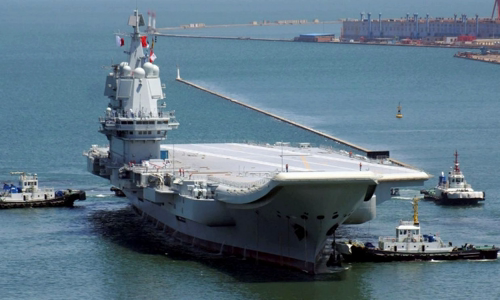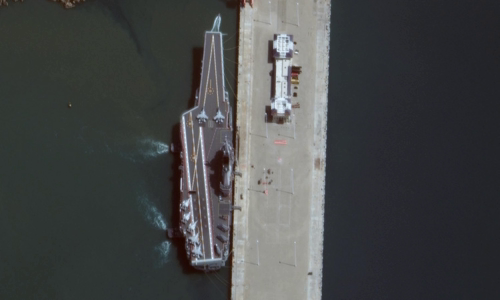If dispatching Shandong aircraft carrier to the South China Sea, China could increase its influence in both the Western Pacific and Indian Ocean.
Shandong aircraft carrier was on service at Sanya base on Hainan island on December 17. It is the first Chinese carrier designed and built by itself and the second Chinese aircraft carrier, after Liaoning. The Shandong staffing helps to put China in the small group of countries with more than one aircraft carrier, including the United States and the United Kingdom. Beijing is also believed to be working on building a third aircraft carrier.

Shandong ship went to sea in early 2019 Photo: SCMP
People's Daily newspaper, the mouthpiece of the Chinese Communist Party, said Shandong would focus on patrolling in the South China Sea instead of training like Liaoning.
Observers assessed the move primarily to show strength and send warning messages to Japan, the United States and Taiwan.
As part of efforts to modernize the Chinese military, navy and air force in recent years, they have conducted "conventional" exercises in order to expand their sphere of influence over the Western Pacific. The Japanese Air Self-Defense Force had to race at a record speed.
Two Chinese aircraft carriers are strong enough to keep Japan "busy". Tokyo, which is currently focusing more on Liaoning, is now based in the northern Chinese city of Qingdao. But now they have to "keep an eye on another carrier in the south," said Collin Koh, an analyst at S. Rajaratnam School of International Studies in Singapore.
Some observers argue that the aircraft carrier has become obsolete in an era of hypersonic precision missiles, which China also possesses. However, others claim that they are still a powerful deterrent tool. The new aircraft carrier is both a symbol of China's prestige and a tool for the country to demonstrate its true military capabilities.
"China has long lamented that it is the only country among the five permanent members of the UN Security Council to have no aircraft carrier (locally manufactured)," Koh said. "Carrier capability is a tool for China to show its growing military capacity commensurate with its rapidly expanding economic and diplomatic stature."
According to Koh, the aircraft carrier may also offer Chinese leaders political options. "Beijing has learned a lot from the way the US uses aircraft carriers in both peace and war time," Koh commented.
He mentioned the US use of aircraft carriers USS Nimitz and USS Independence as "fire brigade" during the Taiwan Strait Crisis in 1996. At that time, China conducted a series of missile tests to cause pressure on Taiwan's presidential election. In response, US President Bill Clinton ordered the dispatch of warships to the area around Taiwan to spread the message to Beijing. This is considered the largest display of power in Asia since the Vietnam War.
That message always makes China feel insecure. Beijing has poured a lot of money into efforts to build a world-class naval force. The huge cost of carrier development shows that for China, the new carrier is not merely symbolic.
Like Liaoning, China's first aircraft carrier to be refurbished from the Soviet Kuznetsov-class, Shandong is named after a province in the north of the country. The ship used a jump-taking mechanism (STOBAR) instead of a steam catapult (CATOBAR) or more modern electromagnetic catapult like a US aircraft carrier.

Shandong aircraft carrier anchored at its base on Hainan Island in November Photo: Maxar
The Chinese aircraft carrier uses diesel engines to boil water in high-pressure boilers, creating steam to run propeller-driven turbine systems and generators, instead of nuclear reactors to create steam like ships. US airport.
Chinese state media Shandong ships are capable of carrying 36 J-15 fighters, instead of 24 such as the Liaoning. Some analysts question the information as well as the true capability of the Shandong ship, but the Global Times insists that "the second aircraft carrier is not a copy of the first ship and possesses much greater power." .
According to Koh, China continues to invest resources in research and development of carrier-related technologies. This shows that they are "extremely serious in developing a true capacity, not 'a white elephant'," Koh commented.
It is unclear whether the Shandong aircraft carrier will be stationed at the base on Hainan Island, but the organization of the payroll there raises concerns about its attempts to enter the South China Sea with disputed countries and other great powers.
Japan and the United States have no claims in the South China Sea, but both emphasize their commitment to maintaining a free and open Indo-Pacific.
Washington condemns Beijing for aggression in the South China Sea, including illegal construction of artificial islands and the arrival of state-of-the-art weapons. The US is concerned that illegal outposts in the South China Sea could be used by China to restrict freedom of navigation in the world's arterial sea lanes. The US military regularly conducts patrols to maintain freedom of navigation in the area.
Beijing says it is deploying advanced weapons to artificial islands for defensive purposes, but many experts say this is part of China's plan to control the South China Sea.
The dispatch of the new aircraft carrier to Sanya also helps deter the "independence forces in Taiwan," the Global Times quoted an unnamed military source as saying. China has always considered Taiwan a part of its territory waiting for reunification, including by force if necessary.
Koh said the main reason why China deployed the Shandong vessel to the edge of the South China Sea was to "create more favorable conditions to impose influence in both the Western Pacific and Indian Oceans". Placing the Shandong ship in Sanya also helps create a pincer-blocker for Taiwan in the event of an unexpected situation.
In addition to Shandong, satellite images released by a US research institute in May showed that China was building a third aircraft carrier. But despite owning three aircraft carriers, China is still far behind the United States when Washington is staffing up to 10 Nimitz-class nuclear powered aircraft carriers, the expert noted.



 SharonTribe
SharonTribe







